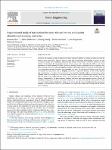Experimental study of interactions between focused waves and a point absorber wave energy converter
| dc.contributor.author | Zhu, G | |
| dc.contributor.author | Shahroozi, Z | |
| dc.contributor.author | Zheng, S | |
| dc.contributor.author | Göteman, M | |
| dc.contributor.author | Engström, J | |
| dc.contributor.author | Greaves, D | |
| dc.date.accessioned | 2023-11-04T12:51:25Z | |
| dc.date.available | 2023-11-04T12:51:25Z | |
| dc.date.issued | 2023-11-01 | |
| dc.identifier.issn | 1873-5258 | |
| dc.identifier.issn | 1873-5258 | |
| dc.identifier.other | 115815 | |
| dc.identifier.uri | https://pearl.plymouth.ac.uk/handle/10026.1/21573 | |
| dc.description.abstract |
Predicting the response of point absorber wave energy converters (WECs) in extreme sea states is crucial for assessing their survivability. However, data are scarce and hydrodynamic understanding is limited. In order to simulate extreme wave conditions, laboratory-scale focused waves based on NewWave theory have been utilized. To investigate the interactions between focused waves and a point absorber WEC, a wave basin experiment has been conducted. Various parameters, including focusing amplitude and peak frequency have been examined across three different damping conditions. The motion response of the point absorber WEC and the corresponding mooring force have been measured over time. The experimental findings reveal that both the focused wave parameters and the damping values have a significant influence on the motion response and mooring force. It is shown that an increase in the focusing amplitude leads to a more intense motion response, while the mooring force is relatively insensitive to the focused amplitude/peak frequency when the end-stop spring is not compressed. The force in the connection line is maximized when the upper end-stop spring is compressed. As the peak frequency increases, the heave and surge responses decrease, whereas the maximum mooring force increases with peak frequency for a locked power take-off (PTO) system. Finally, the results indicate that optimizing the design of the power take-off system, including selecting appropriate damping values and stroke lengths for the translator, can significantly reduce the mooring load for extreme wave conditions. | |
| dc.format.extent | 115815-115815 | |
| dc.language | en | |
| dc.publisher | Elsevier | |
| dc.subject | Wave energy converter | |
| dc.subject | Point absorber | |
| dc.subject | Focused wave | |
| dc.subject | Wave-structure | |
| dc.subject | Mooring force | |
| dc.title | Experimental study of interactions between focused waves and a point absorber wave energy converter | |
| dc.type | journal-article | |
| dc.type | Article | |
| plymouth.author-url | https://www.webofscience.com/api/gateway?GWVersion=2&SrcApp=PARTNER_APP&SrcAuth=LinksAMR&KeyUT=WOS:001077334900001&DestLinkType=FullRecord&DestApp=ALL_WOS&UsrCustomerID=11bb513d99f797142bcfeffcc58ea008 | |
| plymouth.issue | 2 | |
| plymouth.volume | 287 | |
| plymouth.publisher-url | http://dx.doi.org/10.1016/j.oceaneng.2023.115815 | |
| plymouth.publication-status | Published | |
| plymouth.journal | Ocean Engineering | |
| dc.identifier.doi | 10.1016/j.oceaneng.2023.115815 | |
| plymouth.organisational-group | |Plymouth | |
| plymouth.organisational-group | |Plymouth|Research Groups | |
| plymouth.organisational-group | |Plymouth|PRIMaRE Publications | |
| plymouth.organisational-group | |Plymouth|Faculty of Science and Engineering | |
| plymouth.organisational-group | |Plymouth|Faculty of Science and Engineering|School of Engineering, Computing and Mathematics | |
| plymouth.organisational-group | |Plymouth|Research Groups|Marine Institute | |
| plymouth.organisational-group | |Plymouth|REF 2021 Researchers by UoA | |
| plymouth.organisational-group | |Plymouth|Users by role | |
| plymouth.organisational-group | |Plymouth|Users by role|Academics | |
| plymouth.organisational-group | |Plymouth|REF 2021 Researchers by UoA|UoA12 Engineering | |
| plymouth.organisational-group | |Plymouth|Users by role|Researchers in ResearchFish submission | |
| plymouth.organisational-group | |Plymouth|Research Groups|COAST Engineering Research Group | |
| dcterms.dateAccepted | 2023-09-07 | |
| dc.date.updated | 2023-11-04T12:51:25Z | |
| dc.rights.embargodate | 2023-11-7 | |
| dc.identifier.eissn | 1873-5258 | |
| rioxxterms.versionofrecord | 10.1016/j.oceaneng.2023.115815 |


